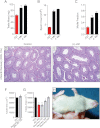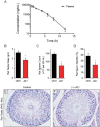Small-molecule inhibition of BRDT for male contraception
- PMID: 22901802
- PMCID: PMC3420011
- DOI: 10.1016/j.cell.2012.06.045
Small-molecule inhibition of BRDT for male contraception
Abstract
A pharmacologic approach to male contraception remains a longstanding challenge in medicine. Toward this objective, we explored the spermatogenic effects of a selective small-molecule inhibitor (JQ1) of the bromodomain and extraterminal (BET) subfamily of epigenetic reader proteins. Here, we report potent inhibition of the testis-specific member BRDT, which is essential for chromatin remodeling during spermatogenesis. Biochemical and crystallographic studies confirm that occupancy of the BRDT acetyl-lysine binding pocket by JQ1 prevents recognition of acetylated histone H4. Treatment of mice with JQ1 reduced seminiferous tubule area, testis size, and spermatozoa number and motility without affecting hormone levels. Although JQ1-treated males mate normally, inhibitory effects of JQ1 evident at the spermatocyte and round spermatid stages cause a complete and reversible contraceptive effect. These data establish a new contraceptive that can cross the blood:testis boundary and inhibit bromodomain activity during spermatogenesis, providing a lead compound targeting the male germ cell for contraception.
Copyright © 2012 Elsevier Inc. All rights reserved.
Figures













Comment in
-
Contraception for men: a breakthrough new approach.Cell. 2012 Aug 17;150(4):667-8. doi: 10.1016/j.cell.2012.07.027. Cell. 2012. PMID: 22901799 Free PMC article.
-
Basic research: Mouse study shows spermatogenesis inhibitor is effective as a reversible male contraceptive.Nat Rev Urol. 2012 Oct;9(10):544. doi: 10.1038/nrurol.2012.176. Epub 2012 Sep 11. Nat Rev Urol. 2012. PMID: 22964584 No abstract available.
Similar articles
-
BET proteins: Investigating BRDT as a potential target for male contraception.Bioorg Med Chem Lett. 2020 Mar 15;30(6):126958. doi: 10.1016/j.bmcl.2020.126958. Epub 2020 Jan 21. Bioorg Med Chem Lett. 2020. PMID: 32019712 Free PMC article. Review.
-
Discovery and characterization of bromodomain 2-specific inhibitors of BRDT.Proc Natl Acad Sci U S A. 2021 Mar 2;118(9):e2021102118. doi: 10.1073/pnas.2021102118. Proc Natl Acad Sci U S A. 2021. PMID: 33637650 Free PMC article.
-
Metabolism of JQ1, an inhibitor of bromodomain and extra terminal bromodomain proteins, in human and mouse liver microsomes†.Biol Reprod. 2020 Aug 4;103(2):427-436. doi: 10.1093/biolre/ioaa043. Biol Reprod. 2020. PMID: 32285106 Free PMC article.
-
Parsing the potential of a new male contraceptive.Nat Med. 2012 Oct;18(10):1466-7. doi: 10.1038/nm.2970. Nat Med. 2012. PMID: 23042348 No abstract available.
-
Brdt Bromodomains Inhibitors and Other Modern Means of Male Contraception.Adv Clin Exp Med. 2015 Jul-Aug;24(4):705-14. doi: 10.17219/acem/33827. Adv Clin Exp Med. 2015. PMID: 26469117 Review.
Cited by
-
Low-hanging fruit: targeting Brdt in the testes.EMBO J. 2012 Oct 3;31(19):3788-9. doi: 10.1038/emboj.2012.259. Epub 2012 Sep 7. EMBO J. 2012. PMID: 22960636 Free PMC article.
-
BET bromodomain inhibitors PFI-1 and JQ1 are identified in an epigenetic compound screen to enhance C9ORF72 gene expression and shown to ameliorate C9ORF72-associated pathological and behavioral abnormalities in a C9ALS/FTD model.Clin Epigenetics. 2021 Mar 16;13(1):56. doi: 10.1186/s13148-021-01039-z. Clin Epigenetics. 2021. PMID: 33726839 Free PMC article.
-
Combined noncanonical NF-κB agonism and targeted BET bromodomain inhibition reverse HIV latency ex vivo.J Clin Invest. 2022 Apr 15;132(8):e157281. doi: 10.1172/JCI157281. J Clin Invest. 2022. PMID: 35426377 Free PMC article.
-
BET proteins: Investigating BRDT as a potential target for male contraception.Bioorg Med Chem Lett. 2020 Mar 15;30(6):126958. doi: 10.1016/j.bmcl.2020.126958. Epub 2020 Jan 21. Bioorg Med Chem Lett. 2020. PMID: 32019712 Free PMC article. Review.
-
Bromodomain and extraterminal (BET) protein inhibition suppresses human T cell leukemia virus 1 (HTLV-1) Tax protein-mediated tumorigenesis by inhibiting nuclear factor κB (NF-κB) signaling.J Biol Chem. 2013 Dec 13;288(50):36094-105. doi: 10.1074/jbc.M113.485029. Epub 2013 Nov 4. J Biol Chem. 2013. PMID: 24189064 Free PMC article.
References
-
- Aston K.I., Krausz C., Laface I., Ruiz-Castané E., Carrell D.T. Evaluation of 172 candidate polymorphisms for association with oligozoospermia or azoospermia in a large cohort of men of European descent. Hum. Reprod. 2010;25:1383–1397. - PubMed
Supplemental References
-
- Buaas, F.W., Kirsh, A.L., Sharma, M., McLean, D.J., Morris, J.L., Griswold, M.D., de Rooij, D.G., and Braun, R.E. (2004). Plzf is required in adult male germ cells for stem cell self-renewal. Nat. Genet. 36, 647–652. - PubMed
-
- Chung, C.W., Coste, H., White, J.H., Mirguet, O., Wilde, J., Gosmini, R.L., Delves, C., Magny, S.M., Woodward, R., Hughes, S.A., et al. (2011). Discovery and characterization of small molecule inhibitors of the BET family bromodomains. J. Med. Chem. 54, 3827–3838. - PubMed
-
- Dieterich, K., Zouari, R., Harbuz, R., Vialard, F., Martinez, D., Bellayou, H., Prisant, N., Zoghmar, A., Guichaoua, M.R., Koscinski, I., et al. (2009). The Aurora Kinase C c.144delC mutation causes meiosis I arrest in men and is frequent in the North African population. Hum. Mol. Genet. 18, 1301–1309. - PubMed
-
- Emsley, P., and Cowtan, K. (2004). Coot: model-building tools for molecular graphics. Acta Crystallogr. D Biol. Crystallogr. 60, 2126–2132. - PubMed
-
- Gu, W., Tekur, S., Reinbold, R., Eppig, J.J., Choi, Y.C., Zheng, J.Z., Murray, M.T., and Hecht, N.B. (1998). Mammalian male and female germ cells express a germ cell-specific Y-Box protein, MSY2. Biol. Reprod. 59, 1266–1274. - PubMed
Publication types
MeSH terms
Substances
Associated data
- Actions
Grants and funding
LinkOut - more resources
Full Text Sources
Other Literature Sources
Molecular Biology Databases

